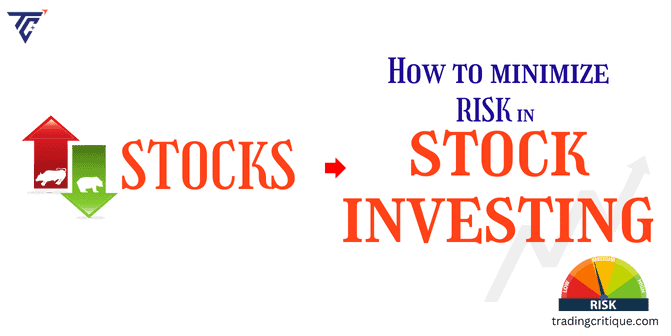8 Best Ways to Minimize Risk in Stocks Investing (2024)
Stocks represent ownership in a company. When you buy stocks, you’re buying a piece of that company. This can give you voting rights, potential dividends, and the chance for your investment to grow if the company does well.

This guide will help you create an investment strategy tailored to your financial situation. You’ll also learn how to mitigate the risks of individual investing and achieve your investment goals.
Quick Insights
Before jumping into stocks, pay off debts and save for emergencies.
Don’t put all your money in one place; invest in different things like stocks and bonds.
Don’t stress over short-term ups and downs; focus on your goals for the future.
What is the risk of buying stocks?
Buying stocks can be a great way to grow your money, but there are some risks you should know about.
Which is the greatest risk when investing in stocks? The greatest risk when investing in stocks is typically market volatility, which can lead to fluctuations in stock prices. This volatility can be influenced by various factors.
Regulatory risk
Different industries have different rules and regulations they need to follow. If a company breaks these rules, it can hurt their profits and stock prices. For example, if a pharmaceutical company loses permission to make a certain drug, it can affect its profits.
Taxability risk
Governments change taxes all the time, which can affect how much money a company makes. If taxes go up, a company might make less profit, which can lower its stock price.
Liquidity risk
If a company has a lot of debts and can’t pay them back, it might go bankrupt. This can happen if they can’t pay their bills or have to cut dividends. It’s a risk you need to consider before investing.
Inflationary risk
When prices of things go up because of inflation, it can hurt companies that need to buy a lot of stuff to make their products. This can lower their profits and stock prices.
Market risk
Market Risk, also known as systematic risk, refers to how prices go up and down in the stock market every day. Even if you pick good individual stocks, if the whole market goes down, your stocks might lose value too.
Business risk
Sometimes, a company’s business isn’t doing well. Maybe the management isn’t good, or they’re not making enough money.
If you put all your money into one company and it doesn’t do well, you could lose a lot. Diversifying, or spreading your money across asset-class companies, can help reduce this risk.
Interest rate risk
Interest rates change, and that can affect stocks. When interest rates are high, companies might find it hard to borrow money, which can hurt their profits and stock prices.
What are some ways you could minimize risk in stocks?
Reducing risk in stock investing involves a variety of investment strategies that aim to mitigate the impact of market volatility and downturns.
Here are some ways you could minimize risk in stocks:
Pay off high-interest debt
If you have debts like credit cards or personal loans with high interest rates, it’s smart to pay those off before investing. The interest you pay on these debts is usually higher than what you’d earn from investing.
Build an emergency fund
It’s important to have some savings set aside for emergencies like unexpected expenses or job loss. Most experts suggest having at least one month’s worth of expenses saved up, but it depends on your situation.
Invest wisely
Once you’ve taken care of debt and have an emergency fund, you can start individuals investing. Here are some tips to reduce risks while investing:
- Dollar-cost averaging: Invest a fixed amount of money regularly instead of all at once. This helps you avoid investing a lot just before the market goes down.
- Choose index funds: These mimic the performance of a whole market, like the S&P 500, and have lower fees than actively managed funds.
- Diversify: Spread your investments across different types of assets like large and small companies, different regions, and sectors. This helps reduce risk.
- Consider bonds, real estate, and other options: These can balance out your portfolio and provide stability.
Be careful with risky investments
It’s okay to take some risks, but only with money you can afford to lose. Speculative investments like penny stocks or cryptocurrencies can be very volatile, so approach them cautiously.
Asset allocation
Asset allocation is like mixing different types of asset classes to keep your money safe and growing. An asset class refers to a group of similar types of investments, such as stocks, mutual funds bonds, real estate, gold, etc.
You might invest in stocks, bonds, real estate, gold, etc. One smart way is to pick investments that don’t usually move in the same direction.
For example, when stocks do well, mutual funds might not, and vice versa. This helps balance the risk and improve your chances of making money over time.
Reinvest dividends
Reinvesting dividends helps compound investment gains over time and avoids opportunity costs and losses from inflation.
Stay calm during market fluctuations
Don’t panic and sell your investments when the market goes down. Stick to your long-term plan and avoid making hasty decisions.
Seek expert advice when needed
While you can manage your investments on your own, it’s okay to consult with a financial planner or investment advisor for personalized guidance. Just make sure you understand the fees and services they offer.
Conclusion
Investing in stocks can be rewarding, but it’s important to understand the level of risk. By paying off high-interest debt, building an emergency fund, and diversifying your portfolio, you can minimize risk.
Additionally, be cautious with speculative investments, reinvest dividends, and stay calm during market fluctuations. Seeking expert advice when needed can provide valuable guidance.
With a good investment goal and prudent risk management, you can enhance your chances of long-term investment success.
Pro Tip
Maximize your trading achievements with our trusted Forex broker! Stay abreast of stocks, CFDs, banking, forex, trading, investment and cryptocurrencies. Find reliable broker reviews to make smart trading decisions.
Frequently Asked Questions
1. How can you minimize risk when investing in stocks?
Minimize stock investment risk by paying off debt, building an emergency fund, and diversifying your portfolio. Be cautious with risky investments, reinvest dividends, and stay calm during market fluctuations. Seek expert advice wisely.
2. What is the 1 rule in trading?
The 1% rule is a way to keep your money safe when trading. It says you should never risk more than 1% of your trading money on one trade. This helps protect your capital and keeps you disciplined when dealing with the ups and downs of the market.
3. Which investor avoids risk?
A risk-averse investor avoids risky bets. They prefer safe investments like government bonds, debentures, and index funds.
4. What are 4 things you can do to minimize risk?
- Understanding and managing risks
- Evaluate the risk
- Create a strategy
- Be prepared to adapt
5. Which trading has the lowest risk?
Fixed annuities, High-yield savings accounts, certificates of deposit (CDs), money market mutual funds, treasury bills, and savings bonds these are generally considered to have the lowest risk.
6. Which is the safest trading?
Long-term investing and investing in broad-based index funds are the safest trading.

Subscribe to
Our Newsletter
Latest Posts
How to Trade Forex | Learn 6 Strategies and Tips
Discover the world of forex trading with our comprehensive guide. Learn essential...
Read MoreFP Markets Review 2024: Everything You Need To Know
Founded in 2005, FP Markets is a leading online broker renowned for...
Read MoreHow to Invest in Ethereum in 2024 – Simple Guide for Beginners
Ethereum is a decentralized blockchain platform that enables smart contracts, enabling secure,...
Read MoreIs Cryptocurrency a Safe Investment? What You Need To Know
Investing in cryptocurrency involves selecting the right cryptocurrency and securely storing your...
Read MoreHow to Read Forex Charts for Beginners • Simple Methods
Traders look for the currency pair price movements, their patterns, and their...
Read MoreBonds: What it is, Types of Bonds & How they Work (2024 guide)
Are you seeking for safe investment with predictable returns? Our 2024 guide...
Read MoreWhat are The Best Crypto Trading Strategies for Beginners in 2024?
Unsure about choosing the best trading strategies for beginners in 2024? This...
Read MoreForex Pairs: How They Work, How To Read, Examples
Forex pairs are combinations of two different currencies that are traded in...
Read MoreBest Ways to Avoid Losses in Forex Trading
Foreign Exchange – Forex market is the world’s largest financial market in...
Read More









